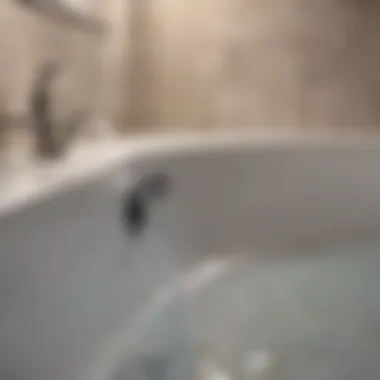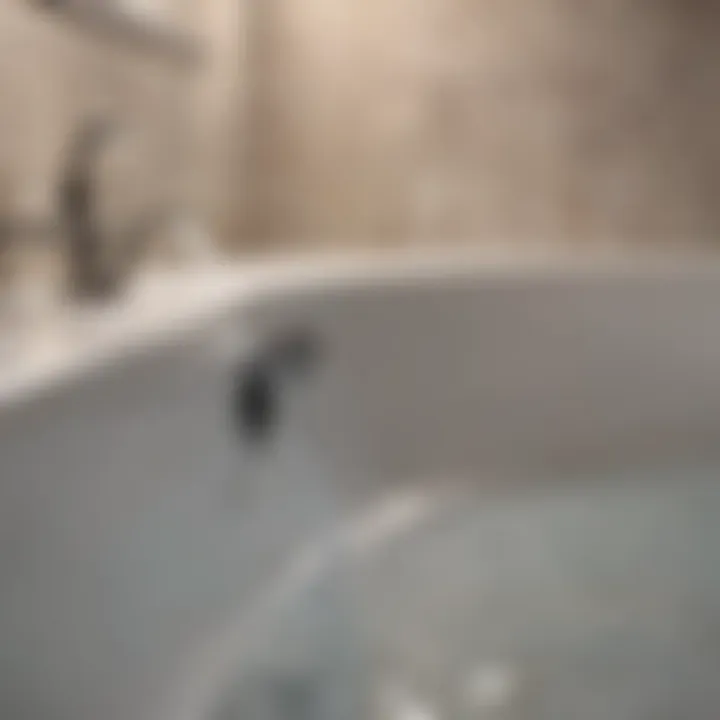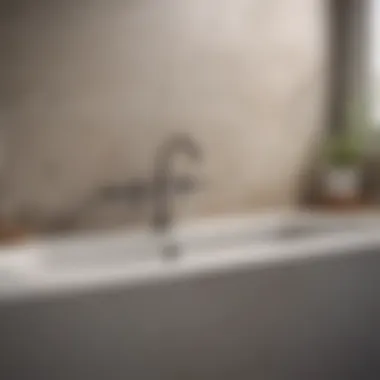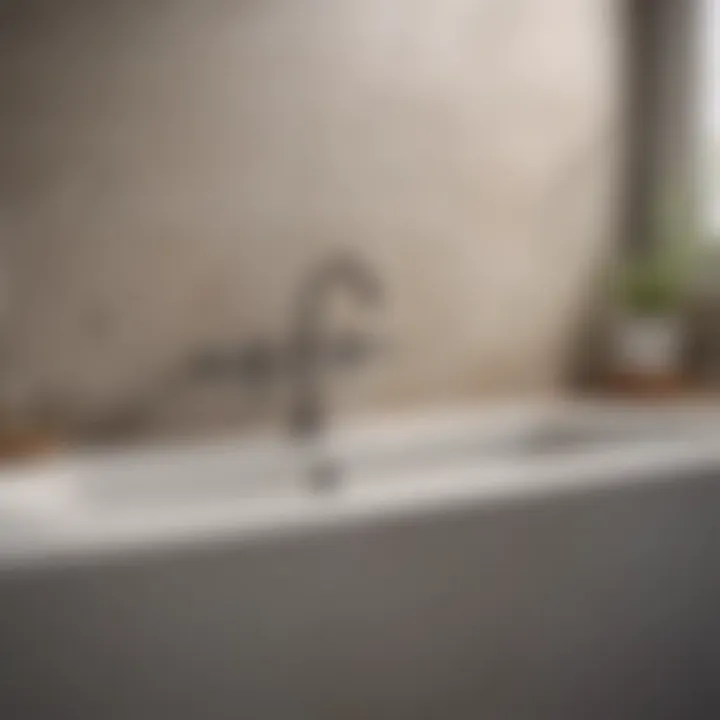Mastering the Art of Snaking a Bathtub Drain


Intro
Snaking a bathtub drain is a common yet often overlooked maintenance task. Many people don’t realize how crucial it is until faced with slow drainage or completely clogged pipes. Understanding how to snake a drain effectively empower homeowners and maintenance professionals alike. This guide explores the essential tools, techniques, and safety measures will enable you to tackle drain problems with confidence.
Featured Homes
Architectural Styles
Bathtubs are present in many architectural styles. Each feature distinct designs and plumbing layouts that might affect your approach to snaking a drain. For instance, modern homes often have simpler, more accessible plumbing systems than older Victorian houses, which may have more complex pipe arrangements.
Unique Design Elements
A unique aspect of a bathtub is how it is incorporated within the home’s design. Some bathtubs are freestanding, while others are built into alcoves. This difference can impact the effectiveness of snaking. Freestanding tubs may allow easier access to the drain, while alcoved bathtubs might require more work to navigate plumbing features often hidden behind walls.
Tools Required
Using the right tools makes all the difference. Consider these items:
- Plumber’s Snake: A flexible auger to break through clogs.
- Drain Auger: Good for more severe blockages.
- Bucket: To collect excess water that might spill out when opening the drain.
- Gloves: To maintain hygiene and protect your hands.
- Flashlight: Helps see in dark areas of the plumbing.
Techniques Employed
Once equipped, the next step is the technique.
- Inspect the Drain: Check for obvious blockages or debris.
- Insert the Snake: Slowly feed the snake into the drain until you meet resistance.
- Break the Clog: Turn the handle to break through the blockage.
- Retrieve the Snake: Pull back gently to avoid losing any material back down the drain.
- Flush the Drain: Use hot water to clear any remaining debris.
Common Issues Encountered
While snaking a drain, you may face several frequent issues:
- Too Much Force: Applying excessive pressure can damage pipes.
- Incomplete Removal: Sometimes clogs might only be partially cleared.
- Tools Getting Stuck: Be cautious while maneuvering the snake.
Safety Precautions
Safety should never be an afterthought. Here are some simple yet effective precautions:
- Always wear gloves and utilize eyewear if necessary.
- Ensure the area is dry to prevent slips.
- Check if the pipes are metal or plastic, as this dictates the type of snake to use.
"Properly maintaining your bathtub drain can save you from future complications and ensure its longevity."
Culmination
Snaking a bathtub drain is an essential skill for all homeowners. Understanding the tools available, the techniques to employ, and the potential challenges will elevate your confidence in managing drainage problems. With this knowledge, you can ensure your bathtub drain functions optimally, enhancing both the aesthetic and operational aspects of your home.
Prelude to Bathtub Drain Issues
Understanding bathtub drain issues is crucial for maintaining a functional bathroom. When tub drainage systems fail, it can lead to slow drainage or complete blockages. Addressing these problems not only enhances the usability of the bath area but also helps prevent issues from escalating. Regularly assessing the health of a bathtub drain can save homeowners time and money in the long run.
Understanding Drainage Systems
Drainage systems in bathtubs work on a simple premise—they transport wastewater away from the tub and into the home’s plumbing system. At a basic level, the system includes the drain, pipes leading to the main sewer line, and sometimes a trap that prevents sewage gases from entering the home.
The effectiveness of this setup relies on gravity and the principle of pressure. Water flows downwards, and air pressure contributes to keeping the flow steady. Over time, various factors can disrupt this process, leading to clogs. This understanding emphasizes the importance of regular checks and maintenance.


Common Causes of Clogs
There are several common factors that lead to clogs in bathtub drains.
- Hair: The most frequent contributor, hair can accumulate over time, forming a thick mass that obstructs water flow.
- Soap Scum: Soap residues can build up in the pipes, particularly if hard water is involved. This creates hard deposits that restrict water passage.
- Foreign Objects: Small items like jewelry or toiletries can accidentally fall into the drain, causing sudden blockages.
- Grease: In rare cases, greasy substances can accumulate and solidify, particularly in older plumbing systems.
Recognizing these causes helps in proactively managing drain health. A preventive approach can significantly reduce the likelihood of serious drain issues later.
The Necessity of Snaking
Snaking a bathtub drain is an essential skill for homeowners and maintenance professionals alike. Understanding the importance of this process can save time, effort, and potential damage to your plumbing. Clogs are common issues, and they can lead to more serious problems if not addressed promptly. Snaking is often a necessary technique to restore proper drainage. It allows you to tackle the obstruction effectively, reducing the need for complicated or costly solutions.
When to Snake a Bathtub Drain
Recognizing the right moment to use a snake is crucial. There are several signs that indicate a bathtub drain might need snaking:
- Slow Drainage: If water takes longer than usual to drain, it often means there is a buildup of debris.
- Gurgling Noises: Sounds coming from your drain when you use water fixtures can signal a blockage.
- Unpleasant Odors: Foul smells may indicate stagnant water trapped behind a clog.
- Backflow: If water starts to bubble back up into the tub, immediate action is required.
Knowing these signs helps you decide when to use a snake rather than relying on temporary fixes that may not address the root cause.
Benefits of Snaking Over Other Methods
Snaking has several advantages when compared to other drain-clearing methods, such as chemical drain cleaners or plungers. Here are some notable benefits:
- Effectiveness Against Stubborn Clogs: Snakes can navigate through tricky plumbing bends, reaching blockages that other methods cannot.
- Eco-Friendly Option: Unlike harsh chemical cleaners, snaking is a mechanical method that does not introduce potentially harmful substances into your home or the environment.
- Cost-Effective: Purchasing a plumbing snake is generally cheaper than continuous buying of chemical products or hiring professionals every time a clog occurs.
- Minimal Risk of Damage: Using a snake reduces the likelihood of damaging pipes, which can happen with uncareful use of plungers or chemicals.
It is vital to consider snaking as a primary approach before opting for other solutions when dealing with plumbing issues.
In summary, recognizing when to snake a bathtub drain and understanding its benefits is vital for maintaining effective plumbing. The significance of this practice cannot be overstated; it not only resolves immediate issues but also contributes to more sustainable home care. With this knowledge in hand, homeowners can confidently tackle the challenges of maintaining their bathtubs.
Tools Required for Snaking
The tools needed for snaking a bathtub drain are integral to achieving a successful unclogging process. Utilizing the correct instruments not only enhances efficiency but also reduces the risk of damaging the plumbing system. A well-equipped homeowner or maintenance professional will find the task much simpler and more effective.
Types of Snake Tools
Various types of snake tools are available on the market, each designed for different kinds of clogs and types of drains.
- Manual Drain Snakes: These are simple tools operated by hand. They consist of a flexible metal cable that can navigate through the curves of the plumbing. Manual snakes come in different lengths and thicknesses. They are ideal for minor clogs but can become tedious for larger blockages.
- Power Drain Snakes: Unlike manual snakes, these tools are motorized and can handle more challenging tasks. Power snake tools are beneficial for deeper blockages, making them suitable for frequent use by professionals. They are usually equipped with a variety of attachments for different clog types.
- Toilet Augers: While primarily designed for toilet clogs, toilet augers can sometimes be useful for bathtub drains as well, especially if the clog is near the entrance of the drain. They have a specialized design that prevents damage to porcelain and drains.
Each of these tools serves its purpose, and selecting the right one is crucial based on the specific clog.
Additional Equipment and Protective Gear
In addition to the snake tools themselves, it is important to have extra equipment and protective gear to ensure the snaking process goes smoothly. This includes:
- Gloves: Wearing durable, rubber gloves protects your hands from exposure to contaminants during the unclogging process.
- Safety Goggles: Protect your eyes from splashes of dirty water or debris that may escape during snaking, offering a layer of safety in what is often a messy job.
- Bucket or Container: Having a bucket on hand allows you to catch any water or debris that may come out of the drain during the process, keeping your workspace clean.
- Towels or Rags: Useful for cleanup, towels help to soak up any spills or messes that occur while you are working on the drain.
- Flashlight: In cases where visibility is limited, a flashlight can be indispensable for spotting where the clog is and assessing the situation more clearly.
By preparing with the right tools and gear, you increase both your efficiency and safety when tackling the task of snaking a bathtub drain.
"Preparation is key; the right tools can make all the difference in successfully clearing a stubborn clog."
Step-by-Step Process of Snaking


When it comes to snaking a bathtub drain, understanding the step-by-step process is essential. Without a clear approach, the task can become frustrating and ineffective. This section outlines the critical steps you need to follow to successfully snake a bathtub drain, ensuring your efforts achieve the desired results. Each step builds on the next, creating a systematic method that eliminates clogs safely and efficiently.
Preparing the Area for Snaking
Before you begin, it is crucial to prepare the area where you will be working. Make sure to remove any items or obstacles that might hinder your access to the drain. This may include bath mats, toiletries, or any other items that could get in your way.
Once the space is clear, the next step involves safeguarding the surfaces around the bathtub. You can lay down old towels or a plastic sheet to catch any debris or water that might escape during the snaking process. It is also a good idea to turn off the water supply to the bathtub to avoid any unwanted water flow.
Proper preparation not only enhances your efficiency but also prevents damage to your bathroom's surfaces during the procedure.
Inserting the Snake Properly
Inserting the drain snake correctly is a pivotal step in this process. First, ensure you have the right type of snake for your specific bathtub drain. Depending on the severity of the clog, you may opt for a manual snake or an electric one.
Begin by removing the drain cover using a screwdriver. With the drain exposed, gently feed the snake into the opening. Avoid forcing the snake into the drain to prevent damage. You should slowly push the snake down the drain, allowing it to follow the natural path of the drainage system. Pay attention to any resistance you may feel, as this indicates a clog or bends in the pipe.
Navigating the Drain with the Snake
Once the snake is inserted, navigating it through the drain is essential for effective clog removal. Apply gentle pressure and rotate the handle of the snake clockwise as you maneuver it deeper. This technique helps the snake to break apart and grasp the debris causing the blockage.
Keep in mind that drains often have bends and turns. It’s vital to feel the snake as it moves through the pipe. If you encounter a bend, maintain a steady pressure and attempt to guide it through. If it gets stuck, carefully pull it back a little before trying again. Notice the feedback you receive through the snake; each change allows you to assess your progress.
Extracting the Clog
Extracting the clog is the final step in the snaking process. Once you feel that you have reached the obstruction, begin to pull back the snake while rotating it slightly. This action can help to dislodge and capture the debris. As you pull the snake out, do so gently and steadily to avoid breaking apart larger chunks that may stick further in the drain.
When the snake is completely out, examine the end of the tool. You should see the debris that caused the clog. Clean the snake thoroughly and dispose of the debris properly. After this, flush your bathtub drain with hot water to ensure all remnants are washed away, and the drainage system is clear.
"Routine maintenance and proper techniques can prevent the headaches of clogged drains."
By breaking down the snaking process into these clear and precise steps, you enhance your ability to effectively manage and resolve bathtub drainage issues. Proper execution of these techniques leads to less frequent clogs and a more functional bathroom.
Recognizing and Dealing with Complications
Understanding how to recognize and respond to complications during the snaking process is crucial for effective maintenance of a bathtub drain. Complications can lead to further issues, including damage to the plumbing, and they can also cause delays in resolving a clog. Being prepared to identify and address these complications equips homeowners and professionals with confidence in dealing with drainage problems.
Identifying Severe Clogs
Severe clogs can manifest in various ways, and it’s important to recognize these signs early. First, look for slow drainage. If water does not flow freely, it may indicate a partial blockage. If the water does not drain at all, this points to a more severe issue. Next, observe any unusual odors emanating from the drain, which can indicate decomposing material. Also, keep an eye out for bubbling water, which suggests air trapped in the pipes due to a clog.
To further assess the severity, conduct a simple test. Fill the bathtub with water and release the drain. Watch for bubbles, gurgling noises, or an unusually slow drain. If the water level rises, you likely have a significant blockage that requires immediate attention.
Understanding your plumbing layout can also be beneficial. Familiarize yourself with where major bends or joins are located in your plumbing system. Severe clogs often occur at these junction points, where debris accumulates more readily.
Common Mishaps During the Process
Several mishaps can occur while snaking a bathtub drain. First, improper handling of the snake can lead to damage. Ensure you are using the right technique to insert and maneuver the snake through the pipes. Using excessive force may break or bend the snake, complicating retrieval.
Also, debris can splash back during the snaking process. This is when the snake encounters significant resistance. To avoid unpleasant surprises, wear appropriate protective gear, such as gloves and goggles. Additionally, ensure to cover areas around the bathtub to prevent any unwanted mess.
Lastly, one may inadvertently push the clog further down the line rather than break it up. This occurs if the snake is not guided correctly. Use gradual movements and be prepared to pull back if resistance is felt.
In summary, recognizing complications and knowing how to address them allows for a smoother snaking experience. Awareness can prevent minor issues from escalating into larger problems, resulting in a more efficient maintenance process. \n


Always err on the side of caution. If you feel uncertain about the severity of a clog or the snaking process, it may be wise to consult a professional.
Preventive Measures
Preventive measures are crucial when it comes to maintaining a bathtub drain's efficiency. Regular attention and appropriate practices prevent build-up and clogs, significantly reducing the need for snaking. This not only saves time but also minimizes the expenses associated with repair services. Homeowners should adopt these practices as part of their regular home maintenance routine.
Routine Maintenance Practices
Routine maintenance practices help to ensure that your bathtub drain operates smoothly. Some of the recommended practices include:
- Regular Cleaning: Clean the drain and its components periodically. Use a mixture of baking soda and vinegar to help dissolve organic materials. This natural solution is effective and safe for plumbing.
- Visual Inspection: Frequently check for signs of water pooling or slow drainage. These are indicators that clogs may be forming. Early detection can save further trouble later.
- Flushing the Drain: It is helpful to flush the drain with hot water on a regular basis. This helps keep smaller debris from accumulating.
- Avoiding Chemical Drain Cleaners: While they may offer a quick fix, chemical cleaners can be harmful to plumbing and the environment. Instead, focus on mechanical removal methods like snaking or plunger usage.
By incorporating these small routines, you can maintain the health of your drain, prolonging its lifespan and functionality.
Effective Drain Covers and Filters
Using effective drain covers and filters is another key preventive measure. These devices catch hair and larger particles before they enter the drain. Consider these points when selecting and using drain covers and filters:
- Proper Fit: Ensure the cover fits snugly to prevent any slipping. A good seal keeps debris from escaping.
- Regular Cleaning: Clean your drain cover or filter regularly to maintain its effectiveness. Clogs can still form on the surface if left unattended.
- Types of Covers: There are various types available such as mesh screens, solid covers, and pop-up stoppers. Choose one based on your needs and the frequency of use which also suits your bathtub design.
- Education on Usage: Educate family members on the importance of keeping items like soap bars and loofahs away from the drain. Simple awareness can avoid significant issues.
Using these devices effectively will minimize the workload on your drain system and enhance its longevity.
Safety Considerations
When dealing with plumbing issues, particularly snaking a bathtub drain, safety must not be overlooked. This encompasses both personal safety and the protection of the plumbing system itself. Recognizing the risks and implementing preventive measures can significantly reduce the likelihood of accidents. Proper awareness enables not just a successful unclogging procedure, but also a safer environment for both the individual performing the task and the plumbing system in question.
Personal Safety during Snaking
Before commencing with snaking a drain, it is crucial to consider personal safety. Using a snake tool can involve physical effort and can lead to potential injuries if not handled correctly. Here are some essential tips:
- Wear Protective Gear: It is advisable to wear gloves to avoid coming into direct contact with debris. Safety goggles can also protect the eyes from splashes or flying debris.
- Maintain Proper Posture: When operating the snake, ensure that your body is in a stable position. Bending or twisting excessively can cause strain.
- Be Cautious with Electrical Tools: If using an electric auger, keep electrical cords away from water. This is vital to prevent electrocution. Always plug tools into a dry outlet.
- Keep Workspace Clear: Ensure that the area around the bathtub is free of any hazards. This might include removing any items from the floor that could cause slipping.
- Have a Clear Plan: Understand the snaking procedure before starting. Knowing what steps to take can help maintain a safe environment.
Always prioritize safety to mitigate risks that can arise during plumbing tasks.
Avoiding Damage to Plumbing
The plumbing infrastructure is an intricate system. Getting a clog out should not compromise the integrity of the pipes. Here are some precautions to consider while snaking a bathtub drain:
- Use the Proper Tool: Ensure that the snake tool fits the drain size. A tool that is too large or too small could lead to damage during insertion.
- Gentle Handling: Insert the snake with care. Forceful jamming can cause bends and breaks within the pipes, leading to more severe plumbing issues.
- Know When to Stop: If you encounter resistance, do not continue pushing. It may indicate that the clog is too dense or that a pipe is damaged.
- Inspect After Use: Once the job is completed, evaluate the plumbing for any signs of damage. If you notice leaks or unusual sounds, it might require professional assistance.
- Utilize Appropriate Techniques: Understanding the recommended methods for handling the snake can aid in reducing risks. Following the manufacturer’s guidelines is always wise.
By adhering to these safety considerations, individuals can better ensure a successful and safe snaking experience, minimizing the risk of injuring themselves or damaging the plumbing system.
Finale
Successfully managing a bathtub drain can be a challenging task. Understanding the complexities involved in snaking is crucial for homeowners and maintenance professionals alike. The process is not merely about unclogging; it involves recognizing underlying issues and preventing future problems.
Summarizing Key Points
In this guide, we have discussed several essential aspects:
- Understanding Drainage Systems: Knowing how drains operate is fundamental to addressing issues.
- Common Causes of Clogs: Identifying the reasons drains get clogged helps in implementing preventive measures.
- The Necessity of Snaking: Knowing when to snake a drain can save time and resources.
- Tools and Techniques: Familiarity with the appropriate tools and methods enhances efficiency in tackling clogs.
- Safety Considerations: Ensuring safe practices is vital for personal safety and preserving plumbing systems.
- Dealing with Complications: Recognizing complications and knowing how to handle them is crucial.
Familiarity with these elements positions homeowners to address drain issues with confidence and effectiveness. Knowledge is empowering, and effective maintenance can lead to fewer interruptions in daily life.
When to Seek Professional Help
While many clogs can be managed at home, there are instances where professional assistance is essential. If:
- Clogs Persist: Attempts to snake the drain do not resolve the issue.
- Severe Plumbing Problems: You suspect larger plumbing issues beyond a simple clog.
- Lack of Experience: If you feel unsure about using the snake tool, it's better to hire a professional.
In those cases, enlisting experienced plumbers can prevent further damage and ensure prompt resolutions. Understanding your limitations is as crucial as the skills you possess, ensuring that your bathtub drainage issues are resolved effectively.















